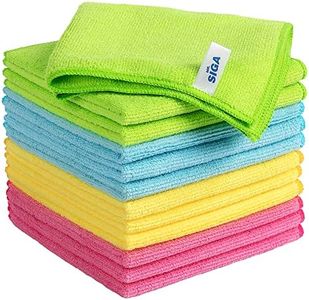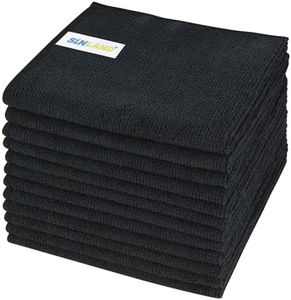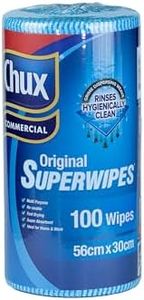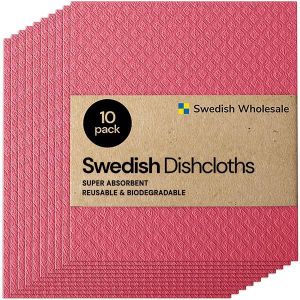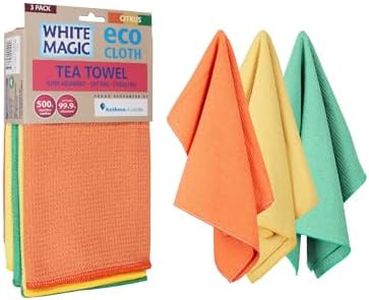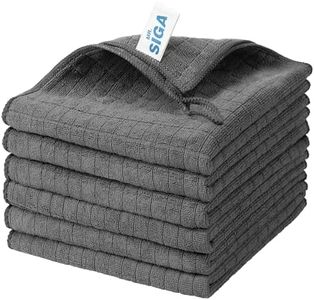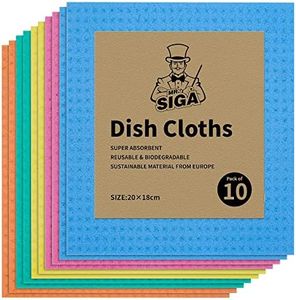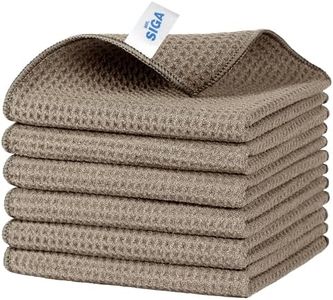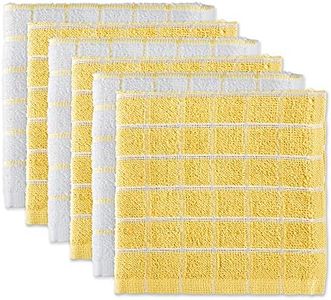We Use CookiesWe use cookies to enhance the security, performance,
functionality and for analytical and promotional activities. By continuing to browse this site you
are agreeing to our privacy policy
10 Best Dish Rags
From leading brands and best sellers available on the web.Buying Guide for the Best Dish Rags
When choosing dish rags, it’s important to find a balance between effectiveness, durability, and comfort. While they may seem like a simple household item, dish rags play a big role in your kitchen for cleaning, drying, and even wiping down surfaces. By paying attention to the right features, you’ll ensure they do the job well, last a long time, and are pleasant to use day after day.MaterialMaterial refers to what the dish rag is made from, and it’s one of the main factors that determines how well it cleans, how long it lasts, and how easy it is to care for. Common options include cotton, microfiber, bamboo, and blends. Cotton is soft, absorbent, and gentle on hands and surfaces, making it popular for general use; microfiber is great for picking up tiny particles and dries fast, ideal for a lint-free finish; bamboo is naturally antibacterial and highly absorbent, perfect for eco-minded users. When deciding, think about whether you want quick-drying, extra absorbent, or easy-to-wash rags to guide your material choice.
AbsorbencyAbsorbency is how much liquid the rag can hold. High absorbency means the cloth can soak up more spills or water, which is useful for drying dishes or cleaning up messes. Lower absorbency cloths may be quicker to wring out and dry, but require more effort for wet jobs. If you mainly use your rags to wash dishes and wipe large spills, pick one with high absorbency; for quick surface wipes or light cleaning, moderate absorbency might be enough.
Texture and ThicknessTexture and thickness indicate how rough or soft the cloth feels and how bulky it is. A textured or slightly rough cloth is better for scrubbing off stuck food and can double as a gentle scouring pad, while a smoother cloth is good for delicate surfaces. Thickness affects both scrubbing power and drying time—a thick rag can be more durable and absorbent but may take longer to dry, while a thin rag dries quickly but may not hold up to tough scrubbing. Choose the texture and thickness based on whether you need a rag mainly for gentle wiping or heavy-duty cleaning.
SizeSize refers to the dimensions of the dish rag. Larger rags cover more area and hold more water but may be harder to wring out, while smaller rags are nimble and easy to handle but require more rinsing. If you prefer cleaning big pots or counters, go for a larger size; for washing delicate glassware or spot cleaning, smaller sizes are more manageable.
DurabilityDurability is about how well the rag stands up to multiple uses and washings without falling apart or losing effectiveness. More durable rags are tightly woven, reinforced around the edges, and made from sturdy materials. If you want something that lasts through frequent use and machine washing, check for durability indicators such as a tightly stitched edge or reinforced seams. Users with heavy cleaning routines will benefit from higher durability.
Ease of CleaningEase of cleaning tells how simple it is to wash and keep your dish rags hygienic. Some rags can be thrown in the washing machine, others are best hand-washed, and some dry very quickly, which helps prevent odors and bacteria. Choose rags that are easy to care for in your usual routine—if you rely on machine washing, make sure the rags are washing-machine safe; if you want to air-dry quickly, pick lightweight or fast-drying fabrics.
Antibacterial PropertiesAntibacterial properties indicate whether the rag is made with materials that resist bacteria buildup. Some natural fibers like bamboo or treated microfiber slow bacterial growth and help reduce odors, which is great if you often let rags hang between uses. If hygiene is especially important to you, choose a dish rag that is more likely to resist smells and stay fresh for longer.
